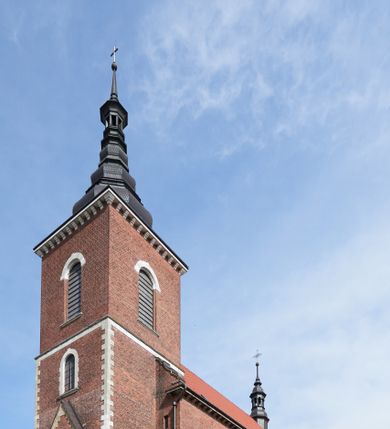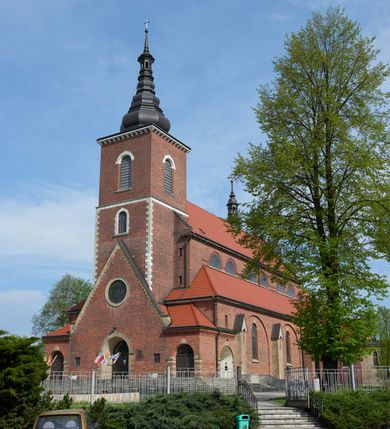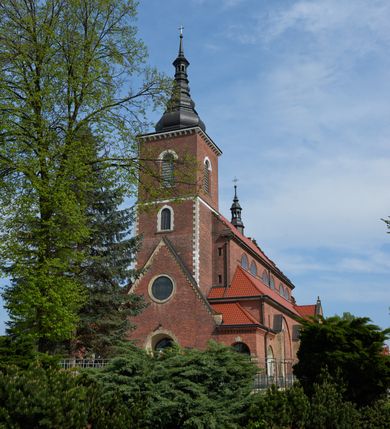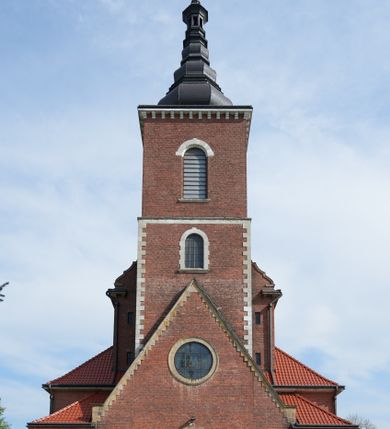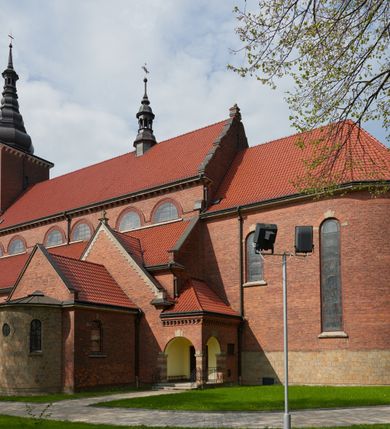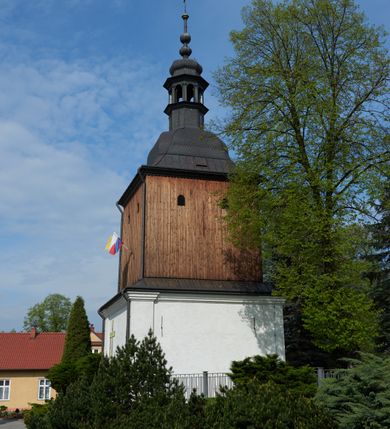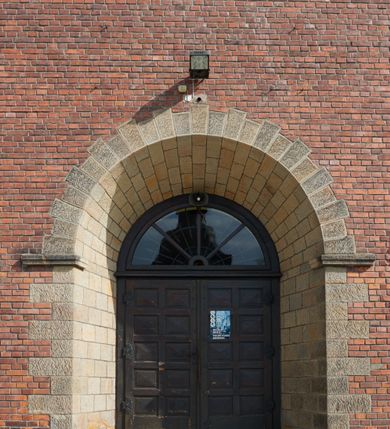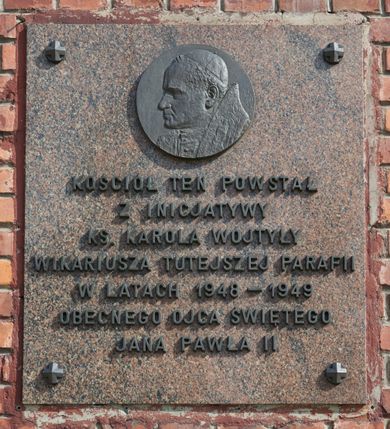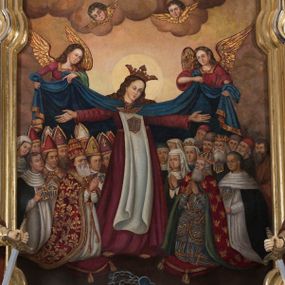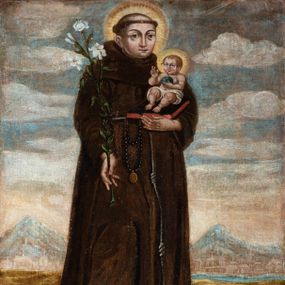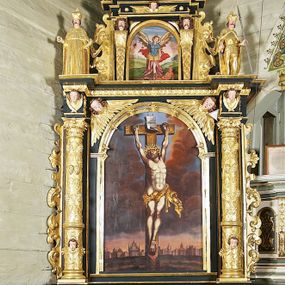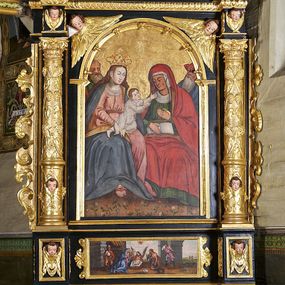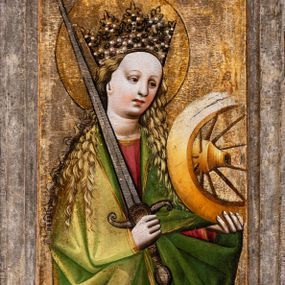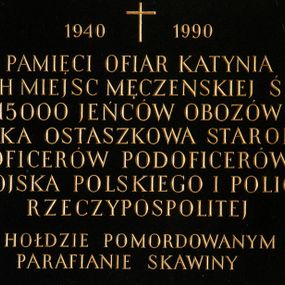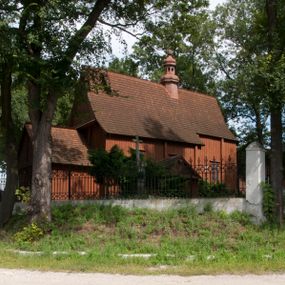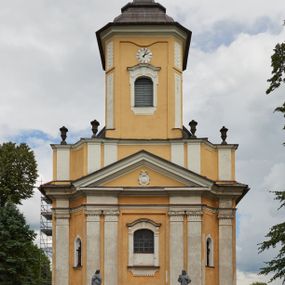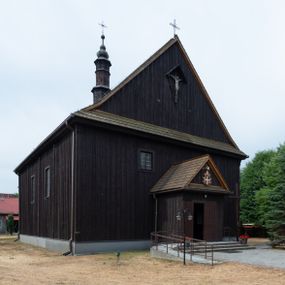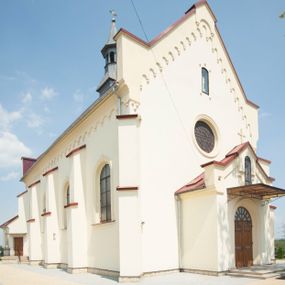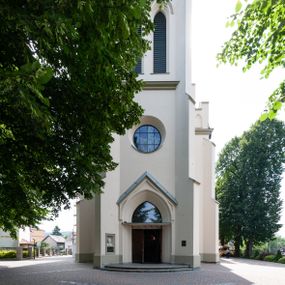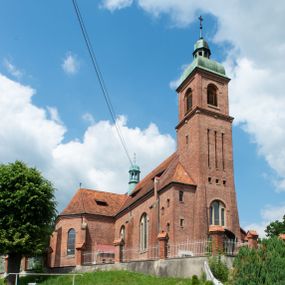
Church of the Assumption of the Blessed Virgin Mary in Niegowić
Identifier
DZIELO/11714
Amount
1
Catalogue note author
Maria Działo
History of work
The church in question is the third temple in Niegowić. The first one was built in 1443 from the foundation of Mikołaj Niewiarowski. In 1761, this church was partly burnt down during the Corpus Christi procession, as a result of shooting a courtly firearm during celebration. During the fire, the most valuable works of art were brought out, including paintings: "Assumption of Virgin Mary" from the high altar, "Holy Kinship" created in 1517, "The Three Marys" painted around 1470, "St. Anthony of Padua" and "Taking down of the Body of Jesus from the Cross", as well as two sculptures of Risen Christ of the 15th and 18th centuries. The second church was erected in 1771 from larch wood from the foundation of Teresa (née Sędzimir) Grzębska, the owner of the property in Niegowić. The church probably did not differ significantly in form compared to the previous temple. It was erected as a log construction on a base, what was characteristic of the gothic churches in the southern Poland. It faced demolition at the turn of the 1920s and 1930s, due to its poor condition. On 16 May 1928, Tadeusz Szydłowski, the Conservator of Monuments from Cracow, gave permission to demolish the church. However, fortunately for the monument, during the measurements carried out before the demolition, an engineer Stefan Żeleński gave an opinion that the temple was not in danger of collapsing. The situation concerning issuing an opinion about the demolition, and then about its appeal, repeated twice. In the end, the parish concentrated on building a parish house, and then a new church, in 1949-1958. The old church served the faithful until 1959, then, while unused, it became to deteriorate. In 1968, the Parish Council informed the Provincial Conservator of Monuments about the poor technical condition of the church. The Metropolitan Curia in Cracow, by way of a letter written by father, Cardinal Karol Wojtyła, propose to relocate the church to Mętkowo. The dismantlement took place in 1973. The new temple dedicated to Madonna of Częstochowa was consecrated on 1 May 1974 by the father, Cardinal Karol Wojtyła. A new bell tower was erected on the pattern of the original one, next to the temple. Meanwhile, the newly built brick church of the Assumption of the Blessed Virgin Mary designed by Bogdan Treter and erected by the residents of Niegowić remained in the town. From 1949, the construction was managed one after the other by: engineer, architect Józef Merenda frm Cracow, and then by engineer Józef Gładki. Michał Hudy from Jadownik was a master builder on the site, and Jan Białota was the so called administrator. The foundation stone was consecrated on 18 June 1954. On 25 September 1966 the church was consecrated by Archbishop Karol Wojtyła. Around 1960, a provisional high altar was built, where a painting of the Assumption of the Virgin Mary from 1610 was placed, transferred from the old temple. The furnishings of the temple were designed in the 1960s by Wiktor Zin. The designs of stained galss windows were made by Władysław Jastrząbski in 1957. Six from the designs representing the Polish saints and blessed, were placed in the chancel. The choice was made by the author of the designs himself, in connection with the celebrations of the millennium of Poland's baptism. The designs were carried out by the Stained Glass Workshop S G Żeleński in Cracow in the years 1957-1965. From 1971, prelate Józef Gąsiorowski was responsible for the finishing works in the church. At the same time, the following furnishings were made: new side altars, fence and stairs made of granite of Strzegom. The tented roof of the tower was made of copper sheet in the years 1998-1999 by the company owned by engineer Dudka from Cracow and by metalsmiths from Biecz. Eight profiling tented roof was made according to the design of Treter. The furnishings of the older church in Niegowić were dispersed. The church housed a 15th-century painting – "The Three Marys," attributed to Nicolaus Haberschrack, which was sold in 1918 to the National Museum in Cracow by then parish priest. The painting "Holy Kinship" from 1516 was found, in turn, in the Bishop's Palace in Cracow. The following works went missing in unknown circumstances: the structures of renaissance and baroque altars transferred to Mętków, the paintings: "St. Anthony" and "Taking down of the Body of Jesus from the Cross" (before 1620), two wooden sculptures of Risen Christ (the third quarter of the 15th century and the first half of the 18th century), rococo pews with the coat of arms of the owners, the Stations of the Cross, as well as liturgical paraments. Those works of art that were transferred to the newly built church in Niegowić practically survived. The present church dedictaed to The Assumption of the the Blessed Virgin Mary, was arranged as a kind of a sanctuary of Pope John Paul II. At the beginning of the 21st century, father Jarosław Cielecki ordered a fresco made by Renato Tarlarini of San Marino (from the foundation of Enrico Mangiarotti's company), depicting father Karol Wojtyła in front of the Virgin Mary. At that time, a new pulpit, a sedilia, a throne and pews were made in the church. In the church porch, thanks to the foundation of John Paul II from Bassano Romano and its chairman, Federico Campelli, a large-format photograph by Arturo Mari, depicting the pope praying in the papal chapel, was hung. A relic of the cross carried by the pope during his last way of the cross in the Colosseum was placed there. Moreover, according to the conception (2014) of the dean Paweł Sukiennik, six slabs were cast in bronze, which were then inserted into the main door. The so-called "doors of Niegowić" were designed by the sculptor Wiesław Domański and depict scenes from the life of Pope John Paul II. However, the most important part of the temple commemorating the Pope is the Chapel of the Divine Mercy, separated from the church's interior, located to the east. In the floor made by Jerzy Malarczyk, a reproduction of the tombstone of John Paul II from Vatican grottoes was placed, which, like the original is made of Carrara marble (the original of the tombstone was transferred to the Sanctuary of John Paul II in Łagiewniki. The pope is also associated with an altar built in his memory (designed by Bogusław Kulka in 2012), a confessional near a chapel with an engraved plaque: "The Confessional of Father Karol Wojtyła," as well as a number of other places and works commemorating the pope.
Abstract
The church in question is the third temple in Niegowić. The first one was built in 1443 from the foundation of Mikołaj Niewiarowski. In 1761, this church was partly burnt down during the Corpus Christi procession, as a result of shooting a courtly firearm during celebration. During the fire, the most valuable works of art were placed outside. The second church was erected in 1771 from larch wood from the foundation of Teresa (née Sendzimir) Grzębska, the owner of the property in Niegowić. At the turn of the 1920s and 1930s, the church was to be demolished. The situation concerning issuing an opinion about the demolition, and then about its appeal, repeated twice. In the end, the parish concentrated on building a parish house, and then a new church, in 1949-1958. The old church fulfilled its function for the faithful until 1959, later – not in use – started to decay. Then it was transferred to Mętków. Meanwhile, a newly built brick Church of the Assumption of the Blessed Virgin Mary, designed by Bogdan Treter, was erected in Niegowić by residents of this village. On September 25, 1966, the church was consecrated by archbishop Karol Wojtyła. Around 1960, a provisional high altar was built, where a painting of the Assumption of the Virgin Mary from 1610 was placed, transferred from the old temple. The furnishings of the temple were designed in the 1960s by Wiktor Zin. Nowadays, the Church of Assumption of the Blessed Virgin Mary has been arranged as a sort of sanctuary of Pope John Paul II, where there is a number of places and works commemorating the Pope. Partly, the church's furnishings also originate from an old wooden temple. Six baroque paintings, stations of the cross and two rococo procession floats were housed in the church. Other four baroque paintings were transferred to the chancel. The following pictures were hung in the chancel: Flagellation of Christ, Teaching Mary, St. Nicholas, Augustine and John the Evangelist, Adoration of the Shepherds and Stigmatization of St. Francis, as well as the painting of Our Lady of the Rosary from 1872 by Saturnin Świerzyński. The remaining furnishings of the older church in Niegowić were dispersed. The church housed a 15th-century painting – "The Three Marys," attributed to Nicolaus Haberschrack, which was sold in 1918 to the National Museum in Cracow by then parish priest. The painting "Holy Kinship" from 1516 was found, in turn, in the Bishop's Palace in Cracow. The structures of renaissance and baroque altars, the paintings "St. Anthony" and "Descent from the Cross" (before 1620), two wooden sculptures of the Risen Christ (3rd quarter of the 15th century and 1st half of the 18th century), rococo benches with the coats of arms of the owners, stations of the cross, as well as liturgical objects – they were lost during their transfer to Mętków, under uncertain circumstances. Those works of art that were transferred to the newly built church in Niegowić practically survived. The newer works are as follows: sculptures in the left side altar: the Most Sacred Heart of Jesus in the centre, St. Augustine and St. Margaret Mary Alacoque on the sides. In the right side altar, on the other side of the temple, there are statues of: St. Joseph, St. Kinga and St. Isidore. The statue of the Most Sacred Heart was made by Cracovian sculptor Karol Muszkiet (1904-1993). Stained glass windows of the church were designed, in turn, by Władysław Jastrzębski (1906-1995). The subject of stained glass windows is closely related to the celebration of the millennium anniversary of the Baptism of Poland. The choir contains pipe organs, made in the Wacław Biernacki company in Cracow in 1958. The goldsmith's collection includes an interesting monstrance from 1914 (from the foundation of Zdzisław and Albina Włodkowie), which is modelled on the 17th-century monstrance of Cracovian bishop Mikołaj Oborski, stored in the treasury of the Wawel Cathedral, as well as a silver goblet from 1918, made in Piotr Seip's goldsmith's workshop in Cracow, according to the design of Jan Bukowski.
Persons related to work
Other works from this place
Other works from this year
Similar works
How to cite?
Maria Działo, "Church of the Assumption of the Blessed Virgin Mary in Niegowić", [in:] "The Sacred Lesser Poland Heritage", 2026, source: https://sdm.upjp2.edu.pl/en/works/church-of-the-assumption-of-the-blessed-virgin-mary-in-niegowic
